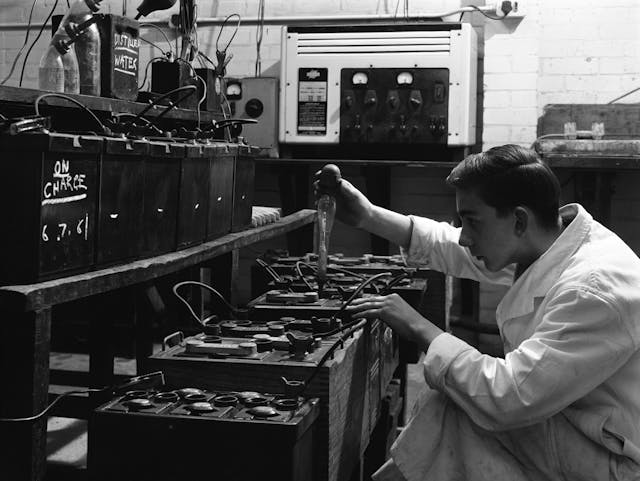Never Stop Driving #45: A new push for EVs
Two days ago, Environmental Protection Agency chief Michael Regan proposed new rules that aim to accelerate the transition to battery-powered cars and call for over half of new cars to be battery-powered in less than 10 years.
What’s the difference between a visionary and a loon? In 1961, when JFK announced that the United States would seek to land a human on the moon before 1970, I bet plenty of people thought he was nuts. There’s huge value, however, in setting ambitious targets for brilliant minds to reach for. Sometimes we fall short, but often, humans find a way. Case in point: We now have a street-legal 1025-horsepower Dodge you can buy from a dealer. I never dared dream of such a thing but perhaps I’m not the visionary type.
There’s a growing realization, however, that the transition to electric cars is going to be much harder than previously thought. This is a complicated topic with so much charged rhetoric that I find it hard to suss out the truth. The Institute of Electrical and Electronics Engineers recently published a sober and comprehensive article on the challenges ahead. When I was a mechanical engineering student at Lehigh University, the EEs were the wicked smart kids, so when their global governing organization speaks, I listen.

I’ve come to love what the latest generation of energy-dense batteries can do. I enjoy my electric dirt bike so much, I’m selling my 1969 Honda CB160, which is gathering dust in my garage. My favorite tool is a cordless Milwaukee impact wrench that’s loosened every nut I’ve asked it to. Yet, I love my gasoline engines, too, especially for the stories behind them.
In the latest Barn Find Hunter video, Tom Cotter takes us on a walking tour of coastal Boothbay Harbor, Maine. Naturally, Hagerty’s chief old-car sleuth, who has an uncanny knack for sniffing out hidden treasure, uncovered a Lotus Eleven that competed in the Mille Miglia, the 1000-mile Italian open-road race (there’s also one for sale on the Hagerty Marketplace). Cotter highlighted the car’s power unit, a four-cylinder engine built by a company called Coventry Climax.
That engine was originally built not for cars, but for fire fighters. The rescue workers needed a lightweight power unit that they could carry to fires and power water pumps. Ingenious racers like Lotus founder Colin Chapman repurposed the motor for car racing. Brilliant. (My colleague Don Sherman explained the fascinating history here.) When I reflect on stories of technological progress and ingenious people, I hesitate to draw conclusions about the viability of long-range goals like the new EPA proposals. Humans are amazing. After all, someone made the Ford GT40.
If you’ve ever wondered how to assign a value to the machine that beat Ferrari at the 24 Hours of Le Mans, this article explains. If that’s too much coin for you, the Porsche 959 is roughly a quarter of the price and our own Henry Catchpole put the most famous 911 of the Eighties through its paces. This seems to be a supercar week as Larry Chen’s latest dispatch brings us a modified Ferrari Enzo. Turn the sound way up for that one! If a Fifties Ford is more your speed this weekend, check out a Hagerty Drivers Club member tribute to his father’s race car.
If you’re a fan of car design, check out this piece on cars drawn by the same Italian design house favored by Ferrari.
Hear from Larry every Friday by subscribing to this newsletter.
***
Check out the Hagerty Media homepage so you don’t miss a single story, or better yet, bookmark it.


“A friend of mine did purchase an EV and had to pay to get the electric service to his home upgraded to handle the charger.”
This is what I don’t understand about EV ownership: why every EV owner feels it’s their God-given right to charge at home.
OK, I get it; if you live in a single-family dwelling, fine, but now we have governments mandating individual charging capability in high-density residential buildings.
These buildings obviously didn’t have individual gas pumps for each residential unit before, so why are we mandating enormous – and expensive – improvements to these buildings’ infrastructure, not to mention the follow-on effect to the pole transformer, transmission lines, local sub-station, etc, etc, etc?
It just seems as if there’s absolutely no science behind this rush to EVs….unlike the US Space Program which EV advocates are so fond of using as model for their policies.
I’d like to see someone much smarter than me conduct an investigative analysis of where we’d be along the development curve if the amount of money dumped into EVs had instead been invested in the development of synthetic fuels. That just seems like a much more intelligent way to attack the problem, but what do I know?
Thanks so much for the link to the IEEE article Mr Webster; these are the people our policy makers should be listening to, not the Mary Barras and Jim Farleys of the world.
The lack of imagination in this thread is amazing. EVs are the future. Maybe not tomorrow, but you can bet your oil burner they will be. I for one can’t wait. The more electric, autonomous transportation blobs for the masses, the better. We in the car world seem to forget that we make up a tiny minority of new car buyers. Especially given the rates at which we cling to our old iron (I’m thoroughly in this crowd, for what it’s worth.) There will be a shift away from fossil fuels once it becomes obvious how independent green energy can make us (as a nation and as individuals) and once the ICE car stops making sense as a business case. Fight the inevitable if you want. You’re only speeding car culture’s demise.
Larry, audience: Why is this transition one that does not include the “Akio Totoda” obvious answer (at least to me) greater use of the Hybrid vehicles?
Seems that we are in an all-or-nothing transition?
Additionally, use of the Hybrid to transition the mindset of the population ?
Discuss…
Oops, the obvious answer to the above set of questions: Common sense is not common.
You are correct, as is Toyota. I would not commit to full electric. I am currently eyeing the new Prius however.
(If I heard myself say that 20 odd years ago, my younger self would have beat me up.)
Anyone worried about the kid with no safety glasses or face shield……Oh yeah i tow alot and and EV’s aren’t ready for that yet.
An EV would work for my family most of the time – my wife’s daily running around the kids and my own 35 mile round trip commute. For the other times that I’m not so sure about, even if an electric truck could tow my tractors, or a 5th wheel camper, or go on an out of town/state trip to pick up another project car, it would be an inconvenience to have to wait to charge along the trip. An inconvenience that I don’t want to deal with. Also, I don’t buy new vehicles. I don’t even buy gently used vehicles. Instead of driving my 2000 F350 7.3 to work every day that I paid $5000 for a few years ago, I drive an old Pathfinder that I bought for $500, and spent $275ish on repairs. Our newest vehicle is my wife’s Toyota, that we bought when it was 10 years old. An EV just can’t financially compete with the kind of bottom-feeding vehicles I fool with. They certainly have merit for a lot of folks, but I don’t want one unless it will be as convenient and cheap as what I’m dealing with now. And even if I had one, I’d still have plenty of ICE vehicles.